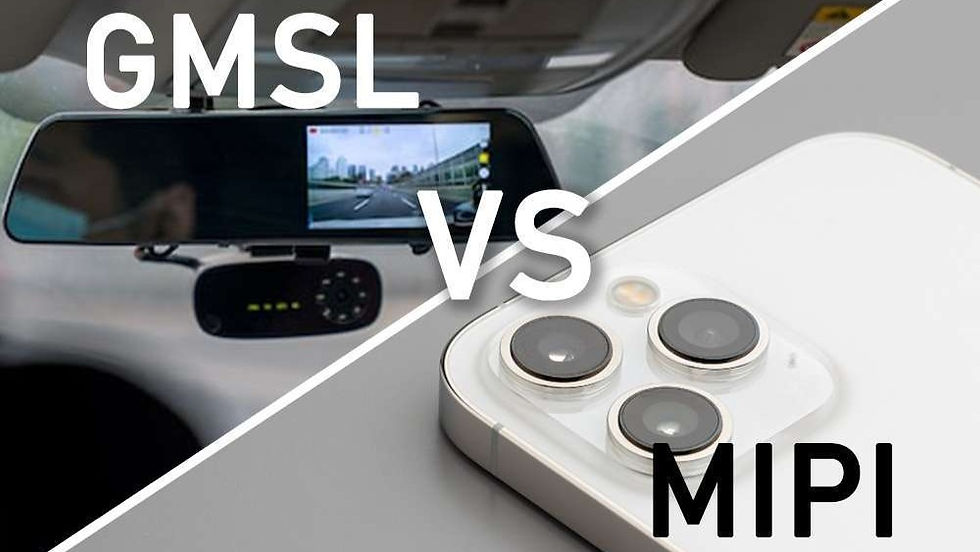GMSL vs MIPI: Where Does GMSL Camera Preferable?
- Vadzo Imaging
- Feb 26, 2022
- 4 min read
Updated: Feb 22

GMSL Camera interfaces are vital for many modern embedded vision applications, including automotive, robotics, and smart cities, requiring high bandwidth, longer-range support, data integrity, and greater performance. Despite the widespread use of interfaces like GigE, USB 3.0, USB 2.0, and MIPI CSI-2, they struggle to meet the increasing demands of new-age applications. To address these challenges, the GMSL camera interface stands out, leveraging the advantages of SerDes technology. SerDes is widely used in cable connection applications, telecom, datacom, and the industrial sector due to its high data rates, long-distance support, and superior performance.
The GMSL camera's high-speed serial interface is ideal for applications such as automotive video, robotics, and agricultural vehicles, offering long-distance transmission capabilities. But how does the GMSL camera compare to MIPI, one of the most widely used camera interfaces? Let's delve into a detailed comparison of MIPI and GMSL camera interfaces, exploring their strengths, limitations, and applications.
Meet the demands of modern embedded vision with our advanced Falcon-1335CRA GMSL camera.
What Sets GMSL Camera Apart?
In several industrial and embedded imaging applications, GMSL (Gigabit Multimedia Serial Link) cameras are the best options since they are multi-purpose, low-power interfaces for delivering high-speed, high-resolution video, power, and bidirectional control data over coaxial cable or single twisted pair for advanced driver assistance systems (ADAS). Numerous robotic and smart traffic applications also make use of GMSL cameras.
The GMSL camera interface, which has a variety of interfaces like HDMI, CSI-2, DSI, asymmetric DSI, eDP, oLDI, and single/dual/quad GMSL1/GMSL2 at the input or output, is made up of families of serializers and deserializers. GMSL cameras employ a serializer on the broadcasting side and a deserializer on the receiver end to convert data from a parallel word to a serial stream for processing.
What is the MIPI Interface?
MIPI high-speed PHY specification is preferred for data transmission in a mobile terminal. With the help of this extremely flexible specification, designers may incorporate many crucial high-speed applications while still complying with the restrictive low-power and EMI specifications necessary for the mobile environment.
The MIPI protocol is used to transmit video and picture data between a camera as well as the host Processor speed. They are a typical part of mobile electronics. The maximum bandwidth for one of the MIPI interface types, MIPI CSI-2, is 6 Gb/s, but the actual bandwidth is around 5 Gb/s. This facilitates high-performance applications and high-resolution photography while also assisting the sensor and embedded board in working as a camera system to take images (to manage and analyze the picture data).
GMSL Camera vs MIPI Camera: The Ultimate Face-off
The GMSL camera interface satisfies the expanding requirement for high bandwidth, quick data rates, data integrity, and improved EMI/EMC performances. The following characteristics will be used to compare and contrast the GMSL and MIPI interfaces:
Transmission Distance
The GMSL SerDes technology can be more beneficial because it allows for long-distance transmission up to a 15-meter distance. These cameras can be mounted up to 15 meters distant from the host processor and still work at full speed, supporting a high frame rate and low latency. For a conventional MIPI CSI-2 camera connection, the longest permitted cable length is 30 cm.
Automatic Repeat Request
To ensure dependable data transmission in GMSL cameras, the error control, and packet recovery technique known as ARQ is used. With this technique, the transmitting side can automatically retransmit packets when the receiving side doesn’t accept the packet to maintain error-free communication. In GMSL2 cameras, ARQ and CRC are used in conjunction to determine whether packets have been received or not. This enables the system’s critical control operations to be highly robust.
Virtual Channel Support
Following the MIPI CSI-2 and CSI-3 requirements, virtual channels are supported. A GMSL camera deserializer can successfully decode a maximum of 16 virtual channel IDs for dual 4-lane MIPI CSI-2. The output from this deserializer is delivered by CSI-2 using virtual channel-identified packets) after this deserializer aggregates all incoming video streams.
Video Duplication
The GMSL camera Splitter mode, which comprises a single serializer coupled to two deserializers, is intended for display applications. It is possible to mask the output of each video pipe to each GMSL PHY in splitter mode.
The reverse splitter mode (also known as aggregation mode) is intended for camera applications and is a single deserializer coupled to two serializers.
Backward Compatibility
The backward compatibility mode is supported by GMSL1 and GMSL2 interfaces. This GMSL1 backward compatibility mode enables the GMSL2 SerDes components to function with the GMSL1 predecessor, which is identical to GMSL2. It is possible to run the GMSL2 backward compatibility mode accordingly. However, the GMSL1 and GMSL2 modes operate differently in certain ways.
After the high-speed PLL locks and the accurate clock are identified, data transmission between the SER and DES commences.
Pricing Range
The best performance is provided by GMSL cameras with longer connections; however, these are not necessary for common or short-distance applications. A GMSL camera costs more than a MIPI or USB camera since it must operate well over longer cable runs. However, there are financial benefits to employing coax cables for SerDes links rather than STP cables.
With the addition of C-PHYSM to MIPI, the system cost has decreased. However, in exceptional cases, additional development expenses may be needed if a driver for the MIPI camera is not widely available.
Make the switch to GMSL today. The Falcon-1335CRA is here to meet your needs.
GMSL vs MIPI: Find the Perfect Camera Interface for Your Embedded Vision Needs
One of the most widely used camera interfaces, in addition to MIPI and GMSL cameras, is USB. However, in most situations, GMSL cameras are the preferred interface over others for embedded vision applications like robotics, ADAS, auto farms, smart traffic systems, infotainment, and so on.
Vadzo Imaging, with its immense experience in camera design, shall be able to support you with a no-obligation consultation to help you select the right interface and technology for your solution by understanding more of your technical as well as commercial requirements.
If you need assistance with including cameras in your products, Contact Us.






